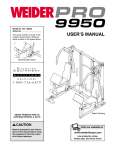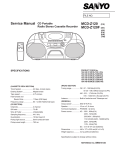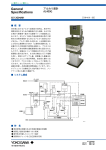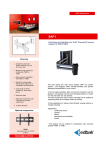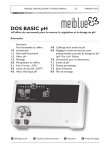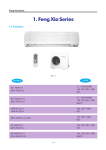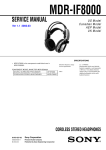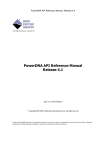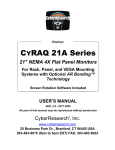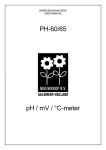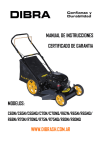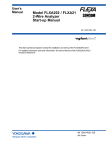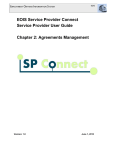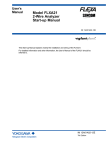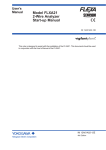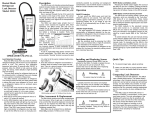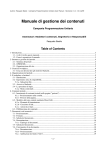Download 1. GENERAL COMBINED PH ELECTRODES (NON
Transcript
1. GENERAL COMBINED PH ELECTRODES (NON-FLOW) SC21(D)-AAP26 • pH, temperature range: 0 to 14 pH, 0 to 110 ºC. • Maximum process pressure 500 kPa. • Glass Resistance (25ºC): 250 to 400 MΩ. • High quality Ag/AgCl reference system (pin) which can stand high temperatures and temperature fluctuations. • A large area PTFE junction to resist fouling to a high degree. • Chemical resistant, steam-sterillisable pH-glass. SC21- AGP24 / ASP24 • pH, temperature range: 0 to 14 pH, 0 to 80 ºC. • Maximum process pressure 500 kPa. • G-Glass Resistance (25ºC): 50 to 100 MΩ. • S-Glass Resistance (25ºC): 25 to 50 MΩ. • Ag/AgCl wire reference system. • pH bulb with cage protection (no breakage when placed in a beaker). • Less maintenance due to the gelled electrolyte and porous PTFE. • Thickened electrolyte (3.3M). SC21(C)-AGP26 • pH, temperature range: 0 to 14 pH, -10 to 100 ºC. • Maximum process pressure 500 kPa. • Glass Resistance (25ºC): 120 to 200 MΩ. • High quality Ag/AgCl reference system (pin) which can stand high temperatures and temperature fluctuations. • Double junction (thickened saturated KCl-solution). The built-in salt bridge prevents poisoning of the reference system. • Heavy duty glass membrane for prolonged operation in corrosive, abrasive and fouling environments (withstanding traces of HF). • A large area PTFE junction to resist fouling. SC21- ALP26 • pH, temperature range: 0 to 14 pH, 10 to 120 ºC. • Maximum process pressure 500 kPa. • Glass Resistance (25ºC): 600 to 900 MΩ. • High quality Ag/AgCl reference system (pin) which can stand high temperatures and temperature fluctuations. • Double junction (thickened saturated KCl-solution). Built-in salt bridge prevents poisoning of the reference system. • Heavy duty glass membrane for prolonged operation in corrosive, abrasive and fouling environments (withstanding traces of HF). • Large area PTFE junction to resist fouling. • Chemical resistant, steam-sterillisable pH-glass. 23 Ø 17 SC21 Liquid outlet 2 = Non-flow 23 = Noryl housing and gelled electrolyte 24 = Filled with gelled electrolyte 26 = Double junction filled with gelled electrolyte 5= Flow 52 = Refillable at the top 55 = Heavy duty flow type Diaphragm C = Ceramic P = PTFE (teflon) Membrane S = Low ohmic G = Universal L = high temperature Reference system A = Ag/AgCl (silver-silverchloride) Connector type = Yokogawa connector D = Din connector C = Compact connector 1.3. SPECIFICATIONS The information about range, specifications, etc. is clearly shown on the type plate attached to the electrode cap. The electrical resistance of the diaphragm is <5kΩ at 25°C. Each temperature increase of 10°C halves the resistance of the membrane. The resistance of the diaphragm depends on the type of the electrode but must be max. 10 kΩ at 25°C in all circumstances. Wrench 17 26 Ø 17 23 PG13.5 Ø 12 120 120 120 Ø 12 SC21C-AGP64 • pH, temperature range: 0 to 14 pH, 0 to 80 ºC • Maximum process pressure 500 kPa • Glass Resistance (25ºC): 75 to 150 MΩ • Ag/AgCl wire reference system • Gelled electrolyte and porous PTFE. • 3.3 molal KCl electrolyte Ø 12 10 15 Fig. 1 SC21-AAP26 G 1/4" Ø 15 Fig. 3 SC21-ASP23 Fig. 2 SC21D-AAP26 COMBINED PH ELECTRODES (FLOW) 18 G 1/4" SC21C-AGC55 • Low ionic application. Positive flow of electrolyte provides the conductivity to measure pH • Heavy duty pH sensitive glass. • Flowing reference system for pollution resistance, and highly stable reference potential. • PG13.5 standard DIN electrode connection. • Use in combination with the presurisable electrolyte reservoir to obtain a positive flow towards the process (K1500YA) 23 Ø 17 91 PG13.5 DIN 40430 PG 13,5 DIN 40430 Ø 12 120 Ø 12 Ø 12 120 4 SC21-AGC11 • Refillable combined laboratory electrode. • pH, temperature range: 0 to 14 pH, 0 to 80 ºC. • Atmospheric pressure. • Glass Resistance (25ºC): 50 to 100 MΩ. • Ag/AgCl reference system. 4.5 Fig. 4 SC21-AGP24 / ASP24 Fig. 6 SC21C-AGC55 Fig. 5 SC21C-AGP64 G 1/4" Ø 17 G 1/4" 23 Ø 17 G 1/4" 23 PG13.5 DIN 40430 Ø 17 23 Ø 12 120 Ø 12 120 120 Ø 12 10 10 Ø 11 Fig. 7 SC21-AGP26 / ALP26 1.2. TYPE NUMBER The type number of a combined electrode is arranged as follows: SC21- ASP23 • Noryl Body (30% glass filled). • Suitable for low temperatures. • pH, temperature range: 0 to 10 pH, 0 to 80 ºC. • Maximum process pressure 500 kPa. • Glass Resistance (25ºC): 40 to 100 MΩ. • Ag/AgCl wire reference system. • Less maintenance by the combination of gelled electrolyte and porous PTFE. G 1/4" G 1/4" Fig. 8 SC21C-AGP26 Fig. 9 SC21-AGC11 2. INSTALLATION Ø9 2.1. PREPARATION FOR USE For accurate pH measurement a gel layer must be formed on the membrane surface. For this reason the pH sensitive part of the electrode should be soaked for 24 hours before the electrode is used. Ø 15 Fig.12 YEF-connector (set of 12 cable nuts). When an electrode has been stored dry and you need to use it immediately (there is no time for soaking), you may do so, but as a result initial regular calibration will be required until the gel layer is formed. 2.2 MOUNTING The combined electrodes must be connected with a Coax cable type WU20(D)-PC.., marked with a blue strip. In areas where electrical interference is likely we recommend to use the Triax electrode cable type WU20(D)-LT.. marked with a blue strip. The cables meets the requirement of IP65 and can be used in temperatures up to 70ºC (Triax) and 110ºC (Coax). Fig. 13 D-connector RESERVOIR FOR SC21C-AGC55 The reservoir, including connection kit and tubing, can be ordered separately. The connection of the tubing to the sensor is described in figure 14. At the reservoir side Yokogawa provides a so called swagelock connection. The electrode when despatched by Yokogawa, has a protective cover cap filled with water around the membrane which ensures you can use the electrode immediately. Flow electrodes (types SC21C-AGC55) have a refill opening which is sealed with a cap or stopper. NOTE: Before installation the above mentioned stopper and protective covercap must be removed. If required, the flow electrodes of the type SC21C-AGC55 may be connected to a reservoir of electrolyte solution. To maintain a correct flow, in non-pressurised systems, the reservoir must be placed so that the level of the electrolyte is above the level of the measuring liquid. Only under these circumstances will the correct electrical contact between reference system and measuring liquid be guaranteed. 16 Ø 17 NOTE: Avoid air bubbles in the tubing. "O"-Ring Ferrule Lock-Ring Nut Tube Fig.10 Standard mounting with mounting set FP20-R12(M), FP20-S12(M) 5+3 mm Fig. 14 Mounting the tube connection for the SC21C-AGC55 PG13.5 K1520JN The cables above are fitted with the standard Yokogawa nut (WU20-) or a DIN nut (WU20D-), the dimensions of which are shown in figure 12. The yokogawa nut can be ordered under part number: K1500DW. Fig.11 Mounting PG13,5 in Yokogawa fitting using the adapter K1520JN (PVC-C) or K1500DV (PVDF) 3. USE AND MAINTENANCE 3.1. GENERAL The isothermal point of intersection of the electrode is at (pH 7 = 0 mV) Regulary check there is sufficient electrolyte solution in the electrode or in the reservoir. The SC21C-AGC55 type sensor is filled with a solution of 3.3 M KCI (i.e.246.9g KCI/1000 g demi-water), which is available as spare part nr: K1520VA. The electrodes of the type SC21(D)-...2. are filled with a gelled electrolyte solution and refilling is not necessary. When there is insufficient electrolyte solution this type of electrode has probably been used at at a temperature too high for this electrode and therefore replacement by another type of electrode is re-commended. 3.2 CALIBRATION AND BUFFERING To calibrate a pH sensor, two buffer solutions with known pH values are required. It is recommended that one buffer solution has a value has near to pH 7.00 (ITP). Depending on the process value to be measured, the second buffer solution should be either acidic (below 7.00) or alkaline (above 7.00). Normally, the IEC buffers (4.01, 6.87 and 9.18) are used. The following is a very general 2-point calibration procedure. 1.Clean the sensor (deposits may be removed using a 5% (approximate) solution of HCL). 2.Rinse sensor thoroughly with clean (demi) water. 3.Immerse the sensor in the first buffer (6.87 pH is recommended). 4.Refer to appropriate Instrument Instruction Manual for Calibration procedures (Auto; Manual; Sample, etc.), 5.Rinse sensor thoroughly with clean (demi) water. 6.Immerse the sensor in the second buffer (4.01 or 9.18 recommended). 7.Repeat Step 4. During calibration the temperature compensation should be active. The instrument automatically compensates for the sensitivity change of the pH sensor at different temperatures. After the calibration is complete replace or re-install the sensor into the process. NOTE: During buffering the liquid earth and the temperature compensator must be connected. The temperature of the buffer solution must be within the limits of the technical specifications as indicated on the type plate. 4. STORAGE When an electrode is to remain unused for a long period, it is necessary to fill the electrode completely with electrolyte solution, to close the refill opening, and to fit the protective cover around the membrane. This must be filled with water. 5. TROUBLE SHOOTING Generally faults are caused by: a. Sensitivity decrease of the membrane. When this occurs the electrode must be cleaned with a suitable detergent. 1. Depositions of hydroxydes lime, iron, hydroxyde can be removed by immersing the electrode in a diluted solution of hydrochloric acid and then rinsing with water. 2. Depositions of oil and fat can be removed by means of hot water in conjunction with a domestic washing solution. When the result is unsatisfactory, a domestic abrasive may be carefully used. 3. Albuminous depositions can be removed by means of a solvent containing: 8,5 ml concentrated hydrochloric acid, 10 g pepsin and 1 liter demi-water. NOTE: When polar solvents are used for special cleaning purposes, it is necessary to soak the electrode for some time after cleaning as the polar solvent influences the gel layer. When an a-polar solvent is used (benzin, ether, toluene) follow up treatment with a polar solvent (methanol, aceton) is necessary. b. Leakage to earth. Fault indications can be expected when the resistance between the reference system and the screening falls below 107 Ω. When a fault accurs, first check if the electrode cable is in a good condition and check if the connector contacts and the terminals in the measuring instrument or connection box are clean and dry. c. Short circuit by break or leakage. The pH meter reading remains approximately pH 7 and is not dependant on the pH value of the liquid being measured. If this occurs the electrode should be replaced. d. Diaphragm poisoning Strongly poluted liquids can cause the diaphragm to foul very quickly, As a result, there will be a transition resistance over the diaphragm. When this resistance exceeds 105Ω instability of reading and incorrect indication of the measured value will occur. The above fault occurs frequently with flow type electrodes when the flow of electrolyte solution is insufficient e.g. with adverse pressure variations due to the medium, pumps or too low electrolyte level. Fouled electrodes can be cleaned with hot water in conjuntion with a domestic washing solution if necessary. When the fouling is caused by fat or hydroxides (lime) cleaning with a organic solvent or diluted acid respectively is recommended. The ceramic diaphragm of electrode types SC21(C)-AGC.. can be cleaned by lightly rubbing with fine emery paper. It may be necessary with non-flow electrode types SC21(D)-...2. to place the electrode for a period in an electrolyte solution at 80°C and let them remain until the solution has completely cooled. e. Poisoning. An electrode can be poisoned by the penetration of the process liquid or by diffusion of components of the process medium through the diaphragm. In addition, the inner liquid in combination with dissolved particles from the process medium may give deposits which block the diaphragm (e.g. silver chloride + sulfide -> deposits of silver sulfide). When poisoning occurs replacement of the electrode will normally be necessary. It is recommended if poisoning of a non-flow electrode occurs to use an alternative type of electrode. f. Poor conduction of the process liquid. When the electrical conduction of process liquid is very low, an unstability of reading will occur. This problem may be cured either by adding electrolyte solution to the process liquid or, if this is not possible, by making the reference input of the measuring instrument high impedance. YOKOGAWA ELECTRIC CORPORATION World Headquarters 9-32, Nakacho 2-chome, Musashino-shi Tokyo 180-8750 Japan www.yokogawa.com YOKOGAWA ELECTRIC ASIA Pte. LTD. 5 Bedok South Road Singapore 469270 Singapore www.yokogawa.com/sg YOKOGAWA CORPORATION OF AMERICA 2 Dart Road Newnan GA 30265 USA www.yokogawa.com/us YOKOGAWA CHINA CO. LTD. 3F Tower D Cartelo Crocodile Building No.568 West Tianshan Road Changing District Shanghai, China www.yokogawa.com/cn Euroweg 2 3825 HD Amersfoort The Netherlands www.yokogawa.com/eu YOKOGAWA MIDDLE EAST B.S.C.(c) P.O. Box 10070, Manama Building 577, Road 2516, Busaiteen 225 Muharraq, Bahrain www.yokogawa.com/bh Yokogawa has an extensive sales and distribution network. Please refer to the European website (www.yokogawa.com/eu) to contact your nearest representative. g. Degrading of the glass membrane. Degrading has one or more of the following effects: – decrease of speed of response – increase of the electrical resistance – decrease of sensitivity – zero point shift The effect of aging of the electrodes makes it necessary to carry out re-calibration of the electrode system regularly. The frequency depends on the required accuracy, the composition of the sample to be measured and the temperature. e.g.: If the life-time of an electrode is 100% at the room temperature it will be 20% at 80°C and only 5% at 120°C. It is possible to re-activate an aged electrode by immersing for 10 seconds in a P.V.C. beaker containing a solution of vinegar (1 mol) and potassium fluoride (1 mol). Ratio 1:1. After this the electrode must be cleaned carefully. WARNING: As a result of strong etching proporties of the acid, the handling should be done carefully and in consultation with a safety officer. 6. CHECK A quick check for correct functioning of a combined electrode can be made as follows. First connect the reference lead of this electrode to the reference input of a pH meter. A known good reference electrode with the same reference system should be connected to the glass electrode input of the meter. After immersing both electrodes in a buffer solution the meter reading should be stable and adjustable to pH 7 (assymetry potential.) If this is possible the reference part of the electrode is functioning correctly. A quick check of the correct functioning of the pH part of the combined electrode can be made by connecting the pH sensitive part to the glass electrode input of a pH meter and a known good reference electrode to the reference lead of this meter. If the calibration procedure described in 3.2 gives a correct adjustment the pH sensitive part of the combined electrode is functioning correctly. User Manual Directions for use combined pH Electrodes IM 12B6J1-30E-E 09-1110 (A) I Printed in The Netherlands, Subject to change without notice Copyright©


